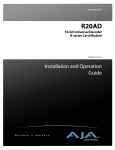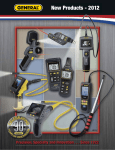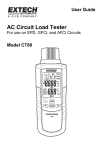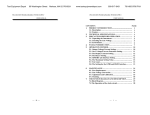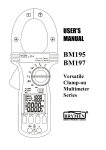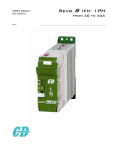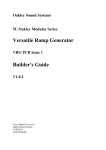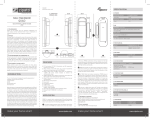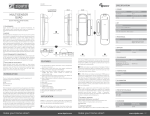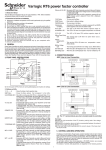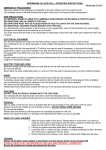Download Manual - Test Equipment Depot
Transcript
99 Washington Street Melrose, MA 02176 Phone 781-665-1400 Toll Free 1-800-517-8431 Visit us at www.TestEquipmentDepot.com AC CIRCUIT ANALYZER USER’S MANUAL CA10 Please read this manual carefully and thoroughly before using this product. TABLE OF CONTENTS Introduction . . . . . . . . . . . . . . . . . . . . . . . . . . . . . . . . . . . . . . . . . . . . 2 Key Features . . . . . . . . . . . . . . . . . . . . . . . . . . . . . . . . . . . . . . . . . . . 3 Safety Instructions . . . . . . . . . . . . . . . . . . . . . . . . . . . . . . . . . . . . . . 3 What's in the Box . . . . . . . . . . . . . . . . . . . . . . . . . . . . . . . . . . . . . . . 3 Product Overview . . . . . . . . . . . . . . . . . . . . . . . . . . . . . . . . . . . . . . . 4 Setup Instructions . . . . . . . . . . . . . . . . . . . . . . . . . . . . . . . . . . . . . . . 5 Install Batteries . . . . . . . . . . . . . . . . . . . . . . . . . . . . . . . . . . . . . 5 Attach Test Cable . . . . . . . . . . . . . . . . . . . . . . . . . . . . . . . . . . . . 5 Operating Instructions. . . . . . . . . . . . . . . . . . . . . . . . . . . . . . . . 5 – 13 Measuring Voltage Parameters . . . . . . . . . . . . . . . . . . . . . . 5 – 7 Measuring Voltage Drop. . . . . . . . . . . . . . . . . . . . . . . . . . . . 7 – 8 Measuring Conductor Impedance . . . . . . . . . . . . . . . . . . . 9 – 11 Testing Residual Current Devices (RCDs). . . . . . . . . . . . . . . . . 11 Testing Ground Fault Circuit Interrupters (GFCIs). . . . . . . . . . . 12 Testing Outlet Wiring . . . . . . . . . . . . . . . . . . . . . . . . . . . . 12 – 13 Other Functions . . . . . . . . . . . . . . . . . . . . . . . . . . . . . . . . . . . . 13 Specifications . . . . . . . . . . . . . . . . . . . . . . . . . . . . . . . . . . . . . . . . . 14 Operating & Maintenance Tips . . . . . . . . . . . . . . . . . . . . . . . . 14 – 15 Replacing the Batteries . . . . . . . . . . . . . . . . . . . . . . . . . . . . . . 14 Housekeeping Hints . . . . . . . . . . . . . . . . . . . . . . . . . . . . . 14 – 15 Warranty Information. . . . . . . . . . . . . . . . . . . . . . . . . . . . . . . . . . . . 15 Return for Repair Policy. . . . . . . . . . . . . . . . . . . . . . . . . . . . . . . . . . 15 INTRODUCTION The CA10 is a special-purpose electrical tester designed to quickly identify and locate single faults in low-voltage (120/240V) AC distribution lines (branch circuits). It can also test the reliability and response time of GFCIs (ground fault circuit interrupters) and RCDs (residual current devices) and check the wiring of outlet sockets. The instrument’s ease of use, versatility and accuracy make it the ideal electrician’s tool for preventing shocks, sparks, electrical fires, equipment damage and poor equipment performance. 2 KEY FEATURES • Measures a branch circuit’s line voltage, peak voltage, neutral-to-ground voltage and frequency • Calculates a circuit’s voltage drop in response to a 12A, 15A or 20A load in order to check the circuit's integrity • Measures the impedance of hot, neutral and ground conductors as well as available short-circuit current (ASCC) • Tests the reliability and response time of GFCIs (ground fault circuit interrupters) and RCDs (residual current devices) • Measures and displays True RMS values of all voltages except peak voltages • Identifies wiring configurations and detects wiring faults and missing ground wires • Compatible with 2- and 3-phase circuits • 2.4 in. diagonal LCD with 30-second backlight • Familiar menu/sub-menu operation • Data hold and 30-minute auto power off functions • Includes 1 ft. long test cable and standard tripod mount • Powered by six “AAA” batteries (included) • One-year limited warranty SAFETY INSTRUCTIONS ! WARNING! ! Exercise caution when working with exposed wiring. Do not use this instrument on circuits carrying voltages higher than 265VAC. WHAT’S IN THE BOX The CA10 comes in an illustrated box containing a soft canvas carrying case. Inside the case are the instrument, a 20 in. (0.5m) long test cable, six “AAA” batteries and this user’s manual. 3 PRODUCT OVERVIEW Fig. 1 shows the controls, indicators and physical features of the CA10. Familiarize yourself with their names and functions before moving on to the Setup Instructions and Operating Instructions. 1 Fig. 2 shows all possible indications on the CA10’s LCD. 2 1. Test cable socket 2. LCD 3. (POWER on/off) button 4. FUNC button 3 4 5 6 10 5. HOLD button 6. 7 8 9 (Backlight) button 7. Submenu (up one line) button 8. Submenu (down one line) button Fig. 1. The controls, display and physical features of the CA10 9. TEST button 10. Battery compartment (on back) Fig. 2. All possible indications on the CA10’s LCD 4 SETUP INSTRUCTIONS INSTALL BATTERIES The CA10 is powered by six “AAA” batteries (included). To install the batteries: 1. Turn the unit over. 2. Remove the one Philips-head screw securing the battery compartment cover (Figure 1, Callout 10) and set it aside. 3. Remove the battery compartment cover and set it aside as well. 4. Install the six supplied “AAA” batteries in the compartment, making sure to match the polarity marks on the batteries with the marks stenciled inside the compartment. 5. Replace the battery compartment cover and secure it with the Philips-head screw. ATTACH TEST CABLE The test cable included with the CA10 has a plug compatible with Americanstyle 110VAC sockets. To attach the cable, plug it into the three-pronged socket at the top of the CA10 (Fig. 1, Callout 1). OPERATING INSTRUCTIONS The symbols of the five main parameters/functions tested by the CA10— voltage (V), voltage drop (Vd), conductor impedance (Z), RCD performance and GFCI performance—are shown below as they appear on the bottom line of the LCD. Use the FUNC button to move from any test to the test on its right. When a test is selected, the border around its text icon is highlighted. MEASURING VOLTAGE PARAMETERS The CA10 can measure four parameters of an AC circuit voltage: 1) the True RMS value of its phase voltage (L-N), 2) the True RMS voltage to earth (ground) of its neutral line (N-E), 3) the peak value of the voltage (Peak), and 4) the frequency of the voltage. Each of the first three parameters is measured and displayed by choosing it from a submenu made available after the FUNC button has been used to select V. By contrast, the frequency of each of the three parameters is displayed on the top line of the LCD. 5 To begin, plug the free end of the test cable into any outlet of the circuit to be tested. Press the or button to cycle through the three submenu options in either direction, as shown in the figure below. The text icon of the parameter being measured appears at the left of the display. The table below the figure shows the normal measurement result for each of the four parameters. It also lists possible causes of, and remedies for, abnormal results. Actual Result Remedy Possible Cause of Abnormal Result Circuit is overloaded Redistribute circuit load Visually inspect all connection points to detect or rule out loose 108 to 132V Phase Voltage connections and defective High impedance Voltage is too (120V circuit) L-N (Nominal point(s) in breaker outlets. If none are high or too low box or circuit Voltage ± 10%) 198 to 242V apparent, locate points of (240V circuit) high impedance using an infrared thermometer (IRT) to detect their heat, or a voltmeter to detect excessive voltage drops across parts. Repair or replace defective wiring/parts. Supply voltage is too Consult your electricity provider high or too low Find source of leakage (a multi-point ground, a device or piece of Leakage current Voltage to earth equipment) and repair >2V >2V of neutral line or replace N-E Check and redistribute load Three-phase imbalance Install spectral filter or take other steps to reduce Harmonic interference interference Supply voltage is too Consult your electricity Peak Voltage provider high or too low (1.414 x Phase 153 to 185V Voltage is too (120V circuit) Voltage, or TRMS 280 to 342V Identify and relocate (if Electronic device in high or too low value of Phase (240V circuit) circuit is distorting necessary) the device Voltage) the AC sine wave Frequency 60Hz (120V circuit) Frequency is too Supply frequency is Consult your electricity 50Hz (240V circuit) high or too low too high or too low provider Parameter 6 Normal Measurement Result Troubleshooting tips: 1) In a single-phase circuit, if the value of L-N is high the leakage current in the neutral line or the earth line will also be high. 2) In a three-phase circuit with a neutral line, if the value of N-E is high the threephase load is either unbalanced or the neutral line is affected by harmonic interference. MEASURING VOLTAGE DROP The CA10 can calculate and display a circuit’s voltage drop in response to application of a 12A, 15A or 20A dummy load. In all three cases, the voltage drop displayed on-screen as a percentage is based on the True RMS value of the drop on the circuit’s phase (live) line. To select the voltage drop test, press the FUNC button until Vd is highlighted. Then, for 120V circuits, press the or button to select the 15A or 20A test (see figure below) to match the rating (maximum load) of the circuit. Alternatively, select the 12A test for a 15A or 20A circuit to avoid tripping the breaker of a “preloaded” circuit (i.e., a circuit serving other loads during the load test). For 240V circuits, select the 12A test. To begin, plug the free end of the test cable into the branch circuit’s outlet that is furthest from the breaker box (distribution panel). Press the TEST button (Fig. 1, Callout 9) to initiate the test. The test result, a percentage, will appear on the lower readout of the display. The normal measurement result of the voltage drop test is a number less than 8%. If your result for the most distant outlet in the circuit is <8%, there is no need to check any other outlet(s) of the circuit closer to the breaker box. If your result is greater than 8%, repeat the test on the outlet that is next-closest to the breaker box. Keep repeating the test until you get a normal measurement result. A voltage drop of more than 8% is usually caused by loose connections, poorly spliced conductors, or conductors that are too thin for the circuit’s load. 7 The table below lists the possible causes of an abnormal result and suggests remedies and additional troubleshooting steps to take. Parameter Normal Measurement Result Actual Result Possible Cause Remedy of Abnormal Result Circuit is overloaded Redistribute load Conductors are too thin for circuit length and/or circuit’s current Voltage drop 0 to 8% Voltage drop is too high High impedance point(s) in breaker box or circuit 8 Replace wiring with heavier-gauge conductors suitable for circuit’s rating Visually inspect all connection points to detect or rule out loose connections and splices, broken or improperly attached twist-on connectors (wire nuts), and defective outlets. If none are apparent, locate points of high impedance using an infrared thermometer (IRT) to detect their heat, or a voltmeter to detect excessive voltage drops across parts. Alternatively, run the Z-L and Z-N impedance tests described in the next section on the hot and neutral conductors; if one conductor produces a much higher reading than the other, it is defective. Repair or replace defective wiring/parts. MEASURING CONDUCTOR IMPEDANCE The CA10 can measure and display the impedance of all three circuit conductors as well as one impedance-related parameter (available short-circuit current, or ASCC). The three impedance values represent the impedances of the phase (live) line (Z-L), the neutral line (Z-N), and the earth (ground) line (Z-E). Available short-circuit current is a measure of the amount of current that would pass through the circuit’s breaker if all of its conductors were to be shortcircuited. It is calculated as Phase Voltage/(Live line impedance + Neutral line impedance). Using the terminology of the CA10: ASCC = (L-N)/(Z-L) + (Z-N). Each of the four impedance parameters is measured and displayed by choosing it from a submenu made available after the FUNC button has been used to select Z. To begin, plug the free end of the test cable into any outlet of the circuit to be tested. Press the or button to cycle through the four submenu options in either direction, as shown in the figure below. The text icon of the parameter selected for measurement appears at the left of the display. To initiate any test, press the TEST button. 9 The table below the figure shows the normal measurement result for each of the four parameters. It also lists possible causes of, and remedies for, abnormal results. Parameter Impedance of live and neutral conductors (Z-L and Z-N) Actual Result Normal Measurement Result <0.15Ω/m for 14AWG conductor <0.1Ω/m for 12AWG conductor Impedance is too high <0.03Ω/m for 10AWG line <1Ω for personnel safety Impedance of ground conductor (Z-E) 10 <0.25Ω for equipment safety Impedance is too high Remedy Possible Cause of Abnormal Result Circuit is overloaded Redistribute circuit load Conductor is too thin for circuit length and/or circuit’s current rating High impedance point(s) in circuit or breaker box Replace wiring with heavier-gauge conductors suitable for circuit’s rating Visually inspect all connection points to detect or rule out loose connections and defective outlets. If none are apparent, locate points of high impedance using an infrared thermometer (IRT) to detect their heat, or a voltmeter to detect excessive voltage drops across parts. Repair or replace defective wiring/parts. Conductor is too thin Replace wiring with heavier-gauge conductors for circuit length suitable for circuit’s and/or circuit’s rating current rating Visually inspect all connection points to detect or rule out loose connections and defective outlets. If none are apparent, locate points of high impedance using an infrared thermometer (IRT) High impedance point(s) in circuit or to detect their heat, or a voltmeter to detect breaker box excessive voltage drops across parts. Alternatively, run the Z-L and Z-N impedance tests on the hot and neutral conductors; if one conductor produces a much higher reading than the other, it is defective. Repair or replace defective wiring/parts. Notes: 1) Be sure any surge suppression system used is properly grounded so it can continue to protect loads during transient overvoltage conditions. 2) Before measuring any parameter, remove any heavy loads from the circuit to avoid producing an inaccurate test result. 3) Before measuring Z-E, be sure to disconnect any RCDs from the circuit to avoid triggering them. 4) A ground connection is required to test the impedance of conductors in 2-wire systems. TESTING RESIDUAL CURRENT DEVICES (RCDs) The CA10 can measure how much current it takes to trip an RCD, and how quickly it responds to an event that should cause a trip. It does so by placing a resistance across the circuit’s live and ground lines, generating a current between them. According to UL, it should take no more than 30mA to cause a trip. The CA10 measures and displays the triggering current (in mA) and the response time (in ms). To select the RCD test, press the FUNC button until RCD is highlighted. Then plug the free end of the test cable into any outlet equipped with an RCD. To initiate the test, press the TEST button. During testing, the display will show the word TEST on the top line. If the device fails to be triggered, the analyzer will stop testing automatically after 6.5 seconds. The table below shows the normal measurement result of RCD testing. It also lists possible causes of, and remedies for, an abnormal result. Parameter RCD reliability and response time Normal Measurement Result RCD trips within specified time Actual Result RCD is too slow to trip Possible Cause of Abnormal Result RCD is installed improperly RCD fails to trip RCD is defective Remedy Check that installation complies with manufacturer’s requirement and relevant standards Repair or replace RCD Notes: 1) Before testing, remove any heavy loads from the circuit to avoid producing an inaccurate test result. 2) A ground connection is required to test RCDs in 2-wire systems. 3) Another common name for a residual current device (RCD) is a residual current circuit breaker (RCCB). 11 TESTING GROUND FAULT CIRCUIT INTERRUPTERS (GFCIs) The CA10 can measure how much current it takes to trip a GFCI, and how quickly it responds to a condition that should cause a trip. It does so by placing a resistance across the circuit’s live and ground lines, generating a current between them. According to UL, it should take no more than 5mA to trigger a trip. The CA10 measures and displays the level of triggering current (in mA) and the response time (in ms). To select the GFCI test, press the FUNC button until GFCI is highlighted. Then plug the free end of the test cable into any outlet equipped with a GFCI. To initiate the test, press the TEST button. During testing, the display will show the word TEST on the top line. If the device fails to be triggered, the analyzer will stop testing automatically after 6.5 seconds. The table below shows the normal measurement result of GFCI testing. It also lists possible causes of, and remedies for, an abnormal result. Parameter GFCI reliability and response time Normal Measurement Result GFCI trips within specified time Actual Result Remedy GFCI fails to trip GFCI is defective Check that installation complies with manufacturer’s requirement and relevant standards Repair or replace GFCI Possible Cause of Abnormal Result GFCI is too slow GFCI is installed to trip improperly Notes: 1) Before testing, remove any heavy loads from the circuit to avoid producing an inaccurate test result. 2) A ground connection is required to test GFCIs in 2-wire systems. TESTING OUTLET WIRING The CA10 automatically checks the wiring of any outlet it is plugged into. The upper part of the display contains the following arrangement of three circles: N stands for the neutral conductor, L for the live conductor, and E for the earth (ground) conductor. If the outlet’s wiring is normal, all three circles will be filled in, as shown in the table on the next page. Different combinations of filled in (on), empty (off) and flashing circles indicate specific faults. 12 Wiring Condition Normal No ground wire detected Live and neutral conductors are reversed Other conditions Screen Display L E N Legend Off On Flashing Any wiring abnormality will prevent the CA10 from performing tests to the full extent of its abilities. For example, in the absence of a ground wire the analyzer can only measure the circuit’s phase voltage and voltage drop. Furthermore, the CA10 cannot detect the voltage between two live lines, multiple concurrent faults, or reversed neutral and ground conductors. OTHER FUNCTIONS Backlight. Pressing the button while the CA10 is powered on turns on the display backlight. If no button is pushed for 30 seconds, the backlight will turn off automatically. You can turn off the backlight manually by pressing the button again. Auto Power Off (APO). A 30-minute APO function is automatically enabled when the CA10 is powered on. When APO is enabled (indicated by a clock icon ( ) at the upper left of the display), if no button is pushed for 30 minutes the CA10 will automatically power off to extend battery life. To disable the APO function, press and hold the FUNC button while pressing the button to power on the unit. The clock icon will not be displayed. Data Hold. Pressing the HOLD button freezes measurements of voltage parameters on the larger, lower readout. Other measurements cannot be held. To release the hold, press the HOLD button again. 13 SPECIFICATIONS Parameter or Component Line Voltage Peak Voltage Line Frequency Voltage Drop Load Voltage Neutral-to-Earth Voltage Live, Neutral and Ground Line Impedance RCD Trip Time RCD Trip Current GFCI Trip Time Display Test Cable Auto Power Off Trigger Display Backlight Duration Operating/Storage Temperature Dimensions Weight (Without Batteries) Power Source Measurement Measurement Resolution Range Accuracy 85 to 265VAC ±1% of reading ± 0.2V 0.1V 121 to 374VAC ±1% of reading ± 0.2V 0.1V 45 to 65Hz ±1% of reading ± 0.2Hz) 0.1Hz 0.1 to 99.9% ±2.5% of reading ± 0.2% 0.1% 10 to 265V ±2.5% of reading ± 0.2V 0.1V 0 to 10VAC ±2.5% of reading ± 0.2V 0.1V 0 to 3Ω ±2.5% of reading ±0.02Ω 0.01Ω >3Ω NA 1 ms to 6.5 sec. ±1% of reading ± 2 ms 1 ms 30 to 37mA ±1% of reading ± 0.2mA 0.1mA 1 ms to 6.5 sec. ±1% of reading ± 2 ms 1 ms Backlit 2.4 in. (61mm) diagonal LCD 12 AWG diameter, 12 in. (305mm) long 30 minutes of inactivity 30 seconds 32° to 122°F (0° to 50°C) ) @ <80% RH 7.6 x 3.1 x 1.5 in. (193 x 78 x 39mm) 10.4 oz. (295g) Six “AAA” batteries OPERATING & MAINTENANCE TIPS REPLACING THE BATTERIES When the (low battery) icon appears on the top line of the display, it’s time to replace the unit’s six “AAA” batteries. Follow the instructions on p. 5 for opening and closing the battery compartment and installing the batteries. HOUSEKEEPING HINTS DO NOT expose the CA10 to: • Direct sunlight • High humidity or temperatures (above 104°F/40°C during operation or 140°F/60°C in storage) • Corrosive or explosive gas • Excessive dust • Strong mechanical vibration or stress (dropping, for example) or electromagnetic radiation 14 If the instrument has been exposed to extreme temperatures, allow several hours for it to acclimate to your local conditions before using it. Do not open the housing of the unit. Doing so voids its limited warranty and could disable its safety circuitry. You may clean the housing of the CA10 with a soft, clean cloth and water or a mild detergent. Never use benzene, alcohol, acetone, ether, ketone, paint thinner, gasoline or an organic solvent. After cleaning, dry the CA10 thoroughly with a clean cloth before using it again. WARRANTY INFORMATION General Tools & Instruments’ (General’s) CA10 AC Circuit Analyzer is warranted to the original purchaser to be free from defects in material and workmanship for a period of one year. Subject to certain restrictions, General will repair or replace this instrument if, after examination, the company determines it to be defective in material or workmanship. This warranty does not apply to damages that General determines to be from an attempted repair by non-authorized personnel or misuse, alterations, normal wear and tear, or accidental damage. The defective unit must be returned to General Tools & Instruments or to a General-authorized service center, freight prepaid and insured. Acceptance of the exclusive repair and replacement remedies described herein is a condition of the contract for purchase of this product. In no event shall General be liable for any incidental, special, consequential or punitive damages, or for any cost, attorneys’ fees, expenses, or losses alleged to be a consequence of damage due to failure of, or defect in any product including, but not limited to, any claims for loss of profits. Test Equipment Depot - 800.517.8431 - 99 Washington Street Melrose, MA 02176 TestEquipmentDepot.com
















